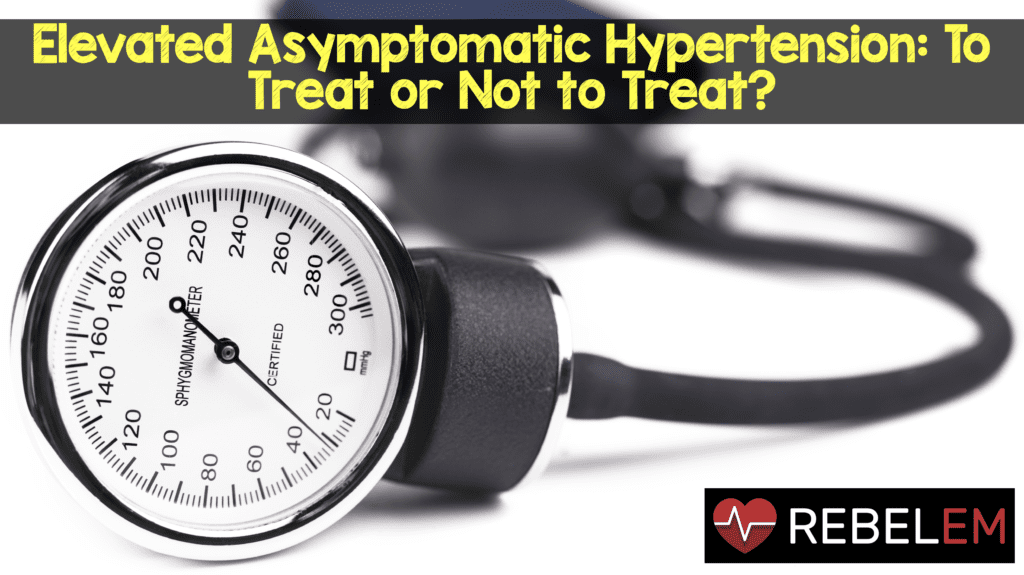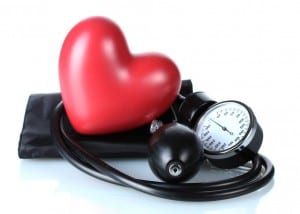
 As emergency physicians, we are constantly on the look out for elevated blood pressures and the potential devastating consequences. We are concerned about intracranial bleeds and acute pulmonary edema from heart failure. But what about the patient that comes in with high blood pressures, yet has no symptoms? Do we need to treat the number or the patient? In this post we will tackle this clinical dilemma of elevated asymptomatic hypertension: To treat or not to treat?
As emergency physicians, we are constantly on the look out for elevated blood pressures and the potential devastating consequences. We are concerned about intracranial bleeds and acute pulmonary edema from heart failure. But what about the patient that comes in with high blood pressures, yet has no symptoms? Do we need to treat the number or the patient? In this post we will tackle this clinical dilemma of elevated asymptomatic hypertension: To treat or not to treat?
Clinical Scenario
A 47-year-old African American male presents to the ED complaining of a laceration to his finger he sustained while cooking. His tetanus is up to date, the bleeding is controlled, and you successfully repair the uncomplicated laceration. Prior to discharge, you review the patient’s vital signs and find a blood pressure of 190/115. The patient has no complaints. What needs to be done about this elevated blood pressure?
Epidemiology and Definitions
In 2008, it was estimated that approximately 30% of adults in the United States were affected with high blood pressure. Less than 50% of these patients reportedly were on appropriate pharmacological treatment. Keeping these statistics in mind, one can see how likely it will be that patients with poorly controlled blood pressure will be seen in the emergency department.
In July 2013, the American College of Emergency Physicians published a clinical policy, addressing patients presenting to the emergency department with asymptomatic elevated blood pressures. ACEP used the Seventh Report of the Joint National Committee on Prevention, Detection, Evaluation and Treatment of High Blood Pressure (JNC 7) for the definition of hypertension (keep in mind JNC 8 was recently released in JAMA 2014). The policy considered markedly elevated blood pressure to be consistent with Stage 2 hypertension (SBP ≥ 160 mmHg, DBP ≥ 100 mmHg).

Clinical Policy [1]
The ACEP clinical policy addressed two separate questions. The first asked if screening for target organ injury reduces the rates of adverse outcomes. The second question asked if medical therapy in the ED reduced rates of adverse outcomes. The writing group “carefully” reviewed and critically analyzed the available medical literature. Level A recommendations are principles based on high degrees of clinical certainty. Level B recommendations identify particular strategies reflecting a moderate degree of clinical certainty. Level C recommendations are made based on panel consensus.
Screening for Target Organ Injury
With a Level C recommendation, ACEP states that routine screening for acute target organ injury (serum creatinine, urinalysis, ECG) is not required. JNC 7 recommends obtaining an ECG (for ischemia/LVH), chest x-ray (for pulmonary edema/cardiomegaly), serum creatinine (for renal dysfunction) and urinalysis (for proteinuria) in patients with hypertension. It must be remembered, however, that JNC 7, and subsequent editions, are geared for the primary care physician. Patients presenting to the ED are not addressed.
Medical Therapy in the ED
With another Level C recommendation, ACEP states that routine ED medical intervention for elevated blood pressure is not required. Select patients (i.e., poor follow up) may be treated and/or have therapy initiated for long-term control of their blood pressure. Whether or not treatment is started, all of these patients should be referred for outpatient follow up. “Longitudinal data continue to suggest that controlling blood pressure over time reduces the incidence of target organ damage, morbidity, and mortality.” (p. 63) It is also generally accepted that rapid lowering of blood pressure in asymptomatic patients has the potential to do harm.

Case Resolution
The patient reports he has been told in the past he has had high blood pressure by his doctor, but has not seen by his primary care provider (PCP) in over one year. You discuss with the patient the need for the patient to follow up with his doctor for repeat blood pressure measurement and give appropriate discharge instructions regarding both wound care and elevated blood pressure. The patient returns ten days later for suture removal and reports he has seen his doctor and was started on medication for his hypertension.
Clinical Bottom Line
Patients with markedly elevated blood pressure (SBP ≥ 160 mmHg, DBP ≥ 100 mmHg) require neither screening diagnostic studies nor acute treatment in the emergency department, as long as they are asymptomatic. Initiation of therapy may be considered in special patient populations, such as those with poor follow up.
References:
- Wolf SJ et al. Clinical Policy: critical Issues in the Evaluation and Management of Adult Patients in the Emergency Department with Asymptomatic Elevated Blood Pressure. Ann Emerg Med 2013. PMID: 23842053
For the JNC 8 Update Summary Checkout:
- Academic Life in Emergency Medicine (ALiEM): Blood Pressure Management in Adults (JNC8 and ACEP Clinical Policy)
The post Elevated Asymptomatic Hypertension: To Treat or Not to Treat? appeared first on REBEL EM - Emergency Medicine Blog.
